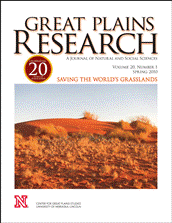Center for Great Plains Studies

Great Plains Research: A Journal of Natural and Social Sciences (through 2013)
Date of this Version
Spring 2013
Document Type
Article
Citation
Great Plains Research 23.1 (Spring 2013), pp. 11-23.
Abstract
The Nebraska Sandhills have been an important resource for better understanding dune activation and the nature of prehistoric Great Plains drought events. However, until recently, few studies have focused on documenting the activation histories of smaller dune fields found along the Great Plains' eastern margin. This study focuses on the Stanton dune field, which lies about 145 km east of the Nebraska Sandhills on an alluvial terrace of the Elkhorn River in northeastern Nebraska. Sediments in the Stanton Dunes were dated with optically stimulated luminescence (OSL) to determine when these dunes were active. The ages indicate three activation periods that cluster into the following time periods: ~5,800-3,800, 960-630, and 510-410 years ago. The ages that fall into our two older clusters closely agree with dune activation records from the Nebraska Sandhills and other major central Great Plains dune fields, suggesting that these large-scale droughts also impacted eastern Nebraska. However, our youngest cluster of ages occurs at a time when the Nebraska Sandhills were thought to be largely inactive, suggesting that the Stanton Dunes may have been activated by a locally important drought event that had a more limited impact on dunes found to the west.


Comments
Copyright © 2013 by the Center for Great Plains Studies, University of Nebraska-Lincoln.